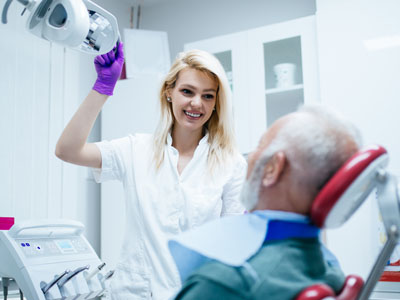


Gum recession refers to the loss of gum tissue along the gumline. This can occur as a result of periodontal disease (gingivitis, periodontitis, advanced periodontitis), the natural aging process, or abrasive habits when it comes to brushing the teeth. When gum recession occurs, the root structure of the tooth becomes exposed. This means that tooth decay and other problems can affect the teeth along the gumline and beneath it. Since healthy gums are essential for a healthy mouth, getting gum recession treated is important for lasting dental wellness. PST is a minimally invasive option for treating gum recession. Unlike traditional grafting techniques, PST is incision and suture free.
Gum recession refers to the progressive exposure of the roots of your teeth due to the loss of gum tissue, often caused by aggressive brushing or periodontal (gum) disease. It's a common problem that can lead to tooth sensitivity, decay, and even tooth loss if left untreated.
The signs of gum recession include:
The most common cause of gum recession is periodontal disease. This occurs when plaque builds up along and under your gumline, causing inflammation and damage to both your gums and supporting bone. Other factors that may contribute to gum recession include:
The Chao Pinhole Surgical Technique (PST) is a minimally invasive method for treating gum recession, unlike traditional gum grafting procedures. Here are some key differences:
Recovery from the Chao Pinhole Surgical Technique (PST) is typically quick and easy compared to traditional gum grafting procedures. Here's what you can expect:
Most patients report minimal discomfort during and after the Chao Pinhole Surgical Technique (PST) procedure. Here's why:
The success rate of the Chao Pinhole Surgical Technique (PST) has been shown to be high, with many patients experiencing long-lasting results. Clinical studies have reported:
During your initial consultation, our team will evaluate your oral health and determine if you're a suitable candidate for the Chao Pinhole Surgical Technique (PST). Some factors we'll consider include:
If we determine that PST is not the best option for you, we'll discuss alternative treatments tailored to your specific needs.
The amount of gum coverage gained through the Chao Pinhole Surgical Technique (PST) may vary from person to person, as it depends on factors such as the severity and extent of your gum recession. In general, patients can expect:
Yes, the Chao Pinhole Surgical Technique (PST) can often be combined with other dental procedures to address multiple oral health concerns simultaneously. Some common combinations include:
To help ensure long-lasting results after the Chao Pinhole Surgical Technique (PST), it's essential to maintain excellent oral hygiene habits and attend regular dental check-ups. Here are some tips:
At the office of Xusheng Mu, DDS we value your time and make it easy to book an appointment for care! With a quick phone call or form submission you could be on your way to a beautiful, straight smile.
Click here to begin your journey.